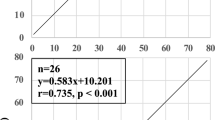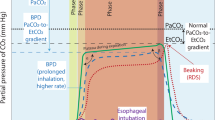Abstract
A small disposable carbon dioxide detector that can be used to provide evidence of correct endotracheal tube placement is now commercially available (FEF). The device contains an indicator that changes color when exposed to carbon dioxide. This study measured the lowest concentration of carbon dioxide causing a perceivable color change in the device. Ten volunteers were blinded to the concentrations of carbon dioxide in an airway circuit/lung model, and the minimal concentration of carbon dioxide that caused a perceivable color change was recorded. The mean minimum concentration required for detection of a color change was 0.54% (4.1 mm Hg) and ranged from 0.25 to 0.60% (1.9 to 4.6 mm Hg). We conclude that this device should produce a detectable color change even in patients with low end-tidal carbon dioxide, as might be observed during cardiopulmonary resuscitation.
Similar content being viewed by others
References
Birmingham PK, Cheney FW, Ward RJ. Esophageal intubation: a review of detection techniques. Anesth Analg 1986;65:886–891
Linko K. Capnography for detection of accidental oesophageal intubation. Acta Anaesthesiol Scand 1983;27:199–202
Bashein G, Cheney FW. Carbon dioxide detection to verify intratracheal placement of a breathing tube. Anesthesiology 1984;61:782–783
Murray IP, Modell JH. Early detection of endotracheal tube accidents by monitoring carbon dioxide concentration in respiratory gas. Anesthesiology 1983;59:344–346
Strunin L, Williams T. The FEF end-tidal carbon dioxide detector (letter). Anesthesiology 1989;71:621–622
Goldberg JS, Rawle PR, Zehnder JL, Sladen RN. Colorimetric end-tidal carbon dioxide monitoring for tracheal intubation. Anesth Analg 1990;70:191–194
Weil MH, Bisera J, Trevino RP, Rackow EC. Cardiac output and end-tidal carbon dioxide. Crit Care Med 1985;13:907–911
Feinstein R, White PF, Westerfield SZ. Intraoperative evaluation of a disposable end-tidal CO2 detector. Anesthesiology 1989;71:A461
Garnett AR, Ornato JP, Gonzalez ER, Johnson EB. Endtidal carbon dioxide monitoring during cardiopulmonary resuscitation. JAMA 1987;257:512–515
Ornato JP, Gonzalez ER, Garnett AR, et al. Effect of cardiopulmonary resuscitation compression rate on endtidal carbon dioxide concentration and arterial pressure in man. Crit Care Med 1988;16:241–245
Falk JL, Rackow EC, Weil MH. End-tidal carbon dioxide concentration during cardiopulmonary resuscitation. N Engl J Med 1988;318:607–611
Gudipati CV, Weil MH, Bisera J, et al. Expired carbon dioxide: a noninvasive monitor of cardiopulmonary resuscitation. Circulation 1988;77:234–239
Author information
Authors and Affiliations
Additional information
Presented in part at the annual meeting of the American Society of Anesthesiologists, New Orleans, October 1989.
Rights and permissions
About this article
Cite this article
Jones, B.R., Dorsey, M.J. Sensitivity of a disposable end-tidal carbon dioxide detector. J Clin Monitor Comput 7, 268–270 (1991). https://doi.org/10.1007/BF01619272
Received:
Revised:
Accepted:
Issue Date:
DOI: https://doi.org/10.1007/BF01619272




